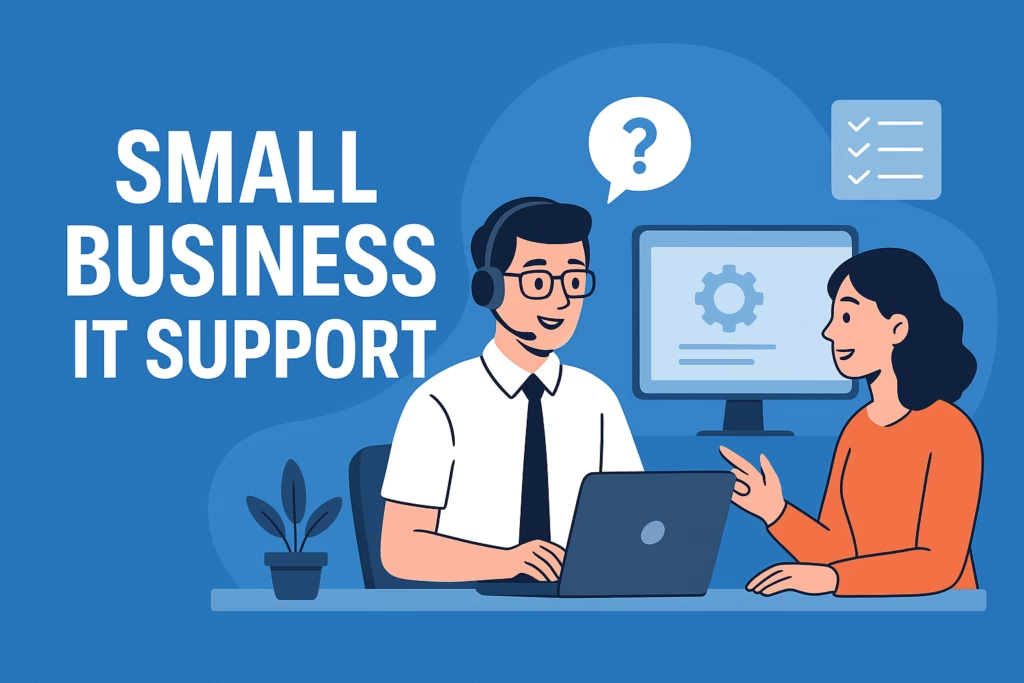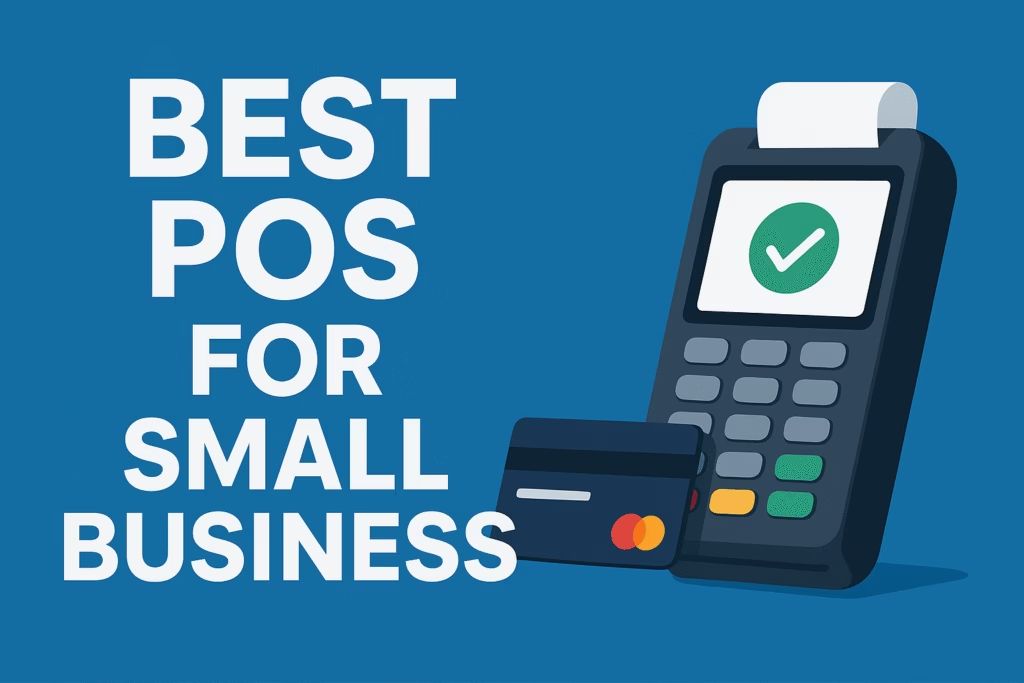Last updated on November 2nd, 2025 at 01:30 pm
Unlock modern Small Business IT Support: 7 game-changing moves to slash downtime, boost security & drive efficiency. Start now and stay ahead!
Table of Contents
Toggle🔥 Why Smart Small Business IT Support Means Survival
Imagine waking up one morning to a crashed server, a ransomware alert and an angry client demanding answers. For a small business, this nightmare isn’t a remote possibility—it’s a looming reality. In fact, the moment you skip proactive IT support, you’re essentially gambling with your business.
Let me tell you from firsthand experience: when I ran my own small business in Delhi, the moment we ignored our IT systems we lost two full work-days while our CRM system was down. That downtime cost us more than the monthly fee for a quality IT support provider.
When you invest in Small Business IT Support, you’re not just buying help with computers—you’re safeguarding your cash flow, reputation and future.
In this deep-dive guide you’ll discover:
-
The hidden challenges facing small businesses today
-
How dedicated IT support transforms operations
-
Real-world data and statistics you can’t ignore
-
Step-by-step strategy to choose, implement & scale IT support
-
FAQs, voice-search friendly answers, and a smart CTA to move forward
Let’s jump right in.
1. The Challenge Landscape for Small Business IT Support
Every small business faces technology challenges—but not all recognise them early. Here’s a breakdown of the biggest issues.
1.1 Cyber-security and data threats
Small businesses might feel “too small to be a target,” but the data tells a different story: over 43% of cyber-attacks target small businesses. cmitsolutions.com+1
For example, downtime due to data loss can cost small businesses $10,000 per hour. cmitsolutions.com
When you’re running on tight budgets and live-client deadlines, one breach or crash can kill your momentum.
1.2 Limited budgets and resource constraints
Many small businesses don’t have a dedicated IT team. According to research, 53% of small orgs feel they are at a disadvantage in terms of IT cost compared to larger firms. networkdepot.com
Plus, the average small business spends 2-7% of revenue on IT-related costs. OSG USA
When you’re juggling staff, stock, clients and cash flow, making IT a priority can feel like a luxury.
1.3 Data management, cloud migration & tech integration
From legacy software to scattered spreadsheets, many small setups struggle with modernising. One article lists “Integration of new technologies” and “Data management & storage” among the top 5 small business IT challenges. eccezion.com
And the barrier to cloud migration is real: limited internal skills, security concerns and budget hold many back. arXiv+1
1.4 Downtime, productivity loss and reactive support
When there is no proactive IT support, issues become reactive fire-fighting. That equals lost productivity. Per one survey, small businesses waste an estimated 12 working days a year due to failing tech. The Sun
It’s not just the repair cost—it’s the opportunity cost, missed sales, frustrated staff, and damaged reputation.
1.5 Scaling up while managing tech demands
As your small business grows, your tech demands grow too. Without the right IT support, systems buckle. According to the U.S. Chamber of Commerce report, 81% of small businesses plan to increase their use of technology platforms. uschamber.com
That makes sense—tech is not optional anymore. It’s strategic.
2. What Does Effective Small Business IT Support Look Like?
Understanding what good support looks like is crucial before you buy anything or sign a contract.
2.1 Levels and models: Managed, Remote, On-site
-
Managed IT services: Full outsourcing of IT infrastructure, strategy, and maintenance. Predictable costs, strong support. Prime Secured+1
-
Remote IT support: Tech issues resolved virtually (software, configurations, helpdesk). Lower cost. joinhomebase.com
-
On-site IT support: When physical infrastructure, cabling, server rooms, hardware are involved. Best for more complex setups. joinhomebase.com
Most small businesses benefit from a hybrid: remote support + occasional on-site + managed services for strategy.
2.2 Key features and targets
When you evaluate a support provider, check if they offer:
-
24/7 monitoring and proactive maintenance (rather than waiting for issues to happen).
-
Strong cybersecurity: firewalls, intrusion detection, data backups, disaster recovery. Systems Solutions+1
-
Scalability: ability to grow with you, add users/devices easily.
-
Cost-predictability: flat-fee or per-user pricing helps budget. joinhomebase.com
-
Strategic IT alignment: not just “fixing problems” but “making tech work for your business goals.”
-
Excellent communication: support that speaks business language, not confusing tech-jargon.
2.3 Benefits of getting it right
-
Reduced downtime → higher productivity.
-
Access to expert tech & security without hiring full-time staff. Systems Solutions
-
Cost savings: outsourcing often cheaper than in-house.
-
Better responsiveness to customers (helps with customer-service expectations). Binary Blue
-
Competitive edge: Small business tech adoption correlates with performance. uschamber.com+1
In short: good IT support isn’t just overhead — it’s a growth enabler.
3. My Story: How Small Business IT Support Saved Us
When I started my consultancy firm 5 years ago in Gurugram, India, we did everything ourselves: basic router setup, shared drives, ad-hoc staff laptops. I remember a Sunday afternoon when the server crashed. It took 6 hours to fix, costing us two missed client calls and one lost contract. That moment was a wake-up call.
We then engaged a small local IT support vendor to monitor our systems. Over 12 months we:
-
Moved email to a cloud platform with managed backups
-
Adopted remote-device management so staff could work secure from home
-
Installed proactive monitoring, so we got alerts before issues became outages
Outcome: downtime went from 6 hours+ per incident, to just minutes; we grew headcount from 10 to 25 without tech hiccups. And yes — we recouped the support cost within a year via efficiency and fewer disruptions.
If you are a small business owner worried your tech is “just fine” for now — ask yourself: How much did that crash cost me? Once you pay attention, you’ll realise investing in quality Small Business IT Support is one of the smartest decisions you’ll make.
4. Step-by-Step Strategy to Choose & Implement Small Business IT Support
Here is a proven roadmap to set you up for success:
Step 1: Assess your current state
-
Make a tech-inventory: hardware, software, licences, users.
-
Document past outages: how long, how much cost?
-
Ask your team: what annoys them most in tech-support?
-
Score yourself on: security, backups, remote access, scalability.
This baseline tells you where you need help most.
Step 2: Define your IT support goals
-
Reduce downtime by X% in 12 months.
-
Improve response time to incidents (e.g., under 30 mins).
-
Migrate to cloud within 6 months.
-
Meet regulatory/compliance standards (GDPR, data protection etc).
Clear goals help you evaluate vendors objectively.
Step 3: Establish budget and ROI criteria
-
If your revenue is $600k/year, expect to spend 2-7% on IT-support related costs. OSG USA
-
Consider “cost of not acting”: backups fail, data loss, reputation damage. Use $10K/hour as a reference. cmitsolutions.com
-
Plan for predictable monthly fee rather than surprise bills.
Step 4: Vet potential IT-support providers
Ask questions like:
-
What industries do you support? Do you have SMB-specific packages?
-
What is your average incident response time?
-
Do you offer 24/7 monitoring and disaster recovery?
-
How will you scale with us as we grow?
-
Are there hidden costs (travel, extra devices)?
-
Can we talk to one of your current small-business clients?
Step 5: Implement in phases
Phase 1 (0-3 months): urgent fixes – backups, security updates, remote access.
Phase 2 (3-9 months): migration – cloud services, device management, process automation.
Phase 3 (9-18 months): strategy – IT roadmap aligned to business goals, analytics, continuous improvement.
Monitoring and review at each phase ensures you stay on track.
Step 6: Train your team & build culture
Technology is only as good as the people using it. Make sure:
-
Staff know how to raise support tickets.
-
Basic cyber-hygiene training is done (passwords, phishing awareness).
-
You incorporate feedback loops: what support issues keep arising?
When your team participates, your IT support investment yields more.
Step 7: Measure, review and adjust
Key metrics to track:
-
Average response time to incidents
-
Number of unplanned outages per month
-
Cost saved from downtime avoidance
-
User satisfaction with support
-
IT support cost as % of revenue
Review every quarter and adjust your agreement accordingly.
5. The Future of Small Business IT Support: Trends to Watch
Staying ahead means anticipating the next wave of change. Here are three major trends.
5.1 AI and automation in IT support
Small businesses won’t be left behind. The U.S. Chamber reports 77% of small-business owners plan to adopt emerging technologies including AI. uschamber.com
AI-powered helpdesks, predictive monitoring and automated patch management will become standard.
5.2 Cloud-first and remote-ready infrastructure
With remote/hybrid working now a norm, robust support for laptops, mobile devices, secure VPNs and cloud apps is vital.
Migration to cloud platforms means your IT support provider must have expertise in those systems — and you need one too.
5.3 Cyber-resilience and regulatory expectations
Cyber-threats keep evolving and even small businesses face regulatory pressures (data protection, privacy).
Managed IT support must include compliance and cyber-resilience — as noted in multiple industry reports. Prime Secured+1
If your business collects any customer data, this is non-negotiable.
6. Practical Tools & Product You Can Use Right Now
Here’s one practical product you can incorporate as part of your Small Business IT Support toolkit—and you can buy it easily on Amazon.
Quick Heal Total Security – A robust AI-based device security software designed for PC-users, offering features like bank-transaction protection, dark-web monitoring and cloud backup.
This makes it an ideal choice for small businesses that want to bolster their endpoint security without a large IT team.
Why promote it? Because one of the most frequent weak-points in small business IT support is the desktop or laptop endpoint. A quality security package helps reduce breaches, boost uptime and give your team confidence.
When you buy this from Amazon you get fast delivery, immediate installation and an easily scalable licence model—perfect for growing small businesses.
Call to action: If you haven’t yet secured your endpoints properly, click through to Amazon now and grab the Quick Heal licence—as a first step in your full small business IT support strategy.
7. FAQs (Voice-search friendly & snippet optimized)
Q1: What exactly does “small business IT support” mean?
A: It means the services, tools, monitoring, consulting and help-desk support tailored to businesses with limited internal IT resources. It covers everything from security and backups to day-to-day user support and strategic tech planning.
Q2: How much should a small business spend on IT support?
A: A typical benchmark is spending 2-7% of annual revenue on IT-related costs. OSG USA But key is to compare with cost of downtime and growth foregone.
Q3: What are the key benefits of small business IT support?
A: Improved productivity, reduced downtime, better security, access to expert resources, predictable costs and the ability to scale. Systems Solutions+1
Q4: How do I choose the right IT support provider?
A: Define your current state, set clear goals, evaluate vendor responses, check references, ensure they offer proactive support, and align their service model to your growth path.
Q5: Can I do IT support in-house for my small business?
A: You can—but it often means higher costs, slower response, reactive rather than proactive fixes, and missed strategic value. Outsourcing or using a hybrid model is often more efficient.
Q6: What’s the role of cloud services in small business IT support?
A: Cloud makes infrastructure scalable, reduces upfront hardware costs, enables remote working, and shifts the burden of maintenance—meaning your IT support provider can focus on value rather than just upkeep.
8. Call to Action
Ready to Transform Your Technology?
Don’t let tech-glitches, downtime or security scares hold your business back. Take the next step:
- ✅ Download our free checklist: “12-Point Small Business IT Support Audit”
- ✅ Schedule a 30-minute consultation with our recommended partner
- ✅ Secure your endpoint protection with Quick Heal Total Security (link below)
(Affiliate link — if you buy, we may earn a small commission at no extra cost to you. Thank you for supporting our free content.)
✅ Final Thoughts
In the fiercely competitive digital age, Small Business IT Support isn’t a luxury—it’s a necessity. By understanding your challenges, choosing the right support model, implementing strategically, and leveraging tools like endpoint security, you position your business for resilience and growth.
Take action now. The cost of doing nothing today will far outweigh the investment you make in your IT infrastructure and support.
Here’s to stronger tech, fewer crises and more growth.
Thinking about launching your dream venture?
Work with Expert Business Consultant Vipin Gandhi
35+ years of helping founders scale
Based in New Delhi, consulting Globally
contact@ecobeko.com
LinkedIn: Vipin Gandhi
📖 To learn how small businesses turn into million-dollar brands, check out: How Small Businesses Became Million-Dollar Brands.
Happy business building! 🚀
Explore More on Business!
Now that you’ve discovered this, why not dive deeper into more Business insights?
Check out these must-read blogs:
✅ 10 Proven Strategies for Business Consulting for Small Business Success
✅ 7 Best World Best Business Opportunity to Start Now!
✅ 10 Proven Ways Small Business Consulting Firms Drive Success
Start Your Website with Hostinger 🚀
Lightning-fast hosting + free domain & SSL. Perfect for entrepreneurs & bloggers!
Save up to 80% — Limited Deal 🔥One-click WordPress — 24/7 Support ✅







